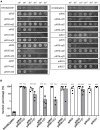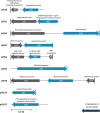Mining for Perchlorate Resistance Genes in Microorganisms From Sediments of a Hypersaline Pond in Atacama Desert, Chile
- PMID: 34367123
- PMCID: PMC8343002
- DOI: 10.3389/fmicb.2021.723874
Mining for Perchlorate Resistance Genes in Microorganisms From Sediments of a Hypersaline Pond in Atacama Desert, Chile
Abstract
Perchlorate is an oxidative pollutant toxic to most of terrestrial life by promoting denaturation of macromolecules, oxidative stress, and DNA damage. However, several microorganisms, especially hyperhalophiles, are able to tolerate high levels of this compound. Furthermore, relatively high quantities of perchlorate salts were detected on the Martian surface, and due to its strong hygroscopicity and its ability to substantially decrease the freezing point of water, perchlorate is thought to increase the availability of liquid brine water in hyper-arid and cold environments, such as the Martian regolith. Therefore, perchlorate has been proposed as a compound worth studying to better understanding the habitability of the Martian surface. In the present work, to study the molecular mechanisms of perchlorate resistance, a functional metagenomic approach was used, and for that, a small-insert library was constructed with DNA isolated from microorganisms exposed to perchlorate in sediments of a hypersaline pond in the Atacama Desert, Chile (Salar de Maricunga), one of the regions with the highest levels of perchlorate on Earth. The metagenomic library was hosted in Escherichia coli DH10B strain and exposed to sodium perchlorate. This technique allowed the identification of nine perchlorate-resistant clones and their environmental DNA fragments were sequenced. A total of seventeen ORFs were predicted, individually cloned, and nine of them increased perchlorate resistance when expressed in E. coli DH10B cells. These genes encoded hypothetical conserved proteins of unknown functions and proteins similar to other not previously reported to be involved in perchlorate resistance that were related to different cellular processes such as RNA processing, tRNA modification, DNA protection and repair, metabolism, and protein degradation. Furthermore, these genes also conferred resistance to UV-radiation, 4-nitroquinoline-N-oxide (4-NQO) and/or hydrogen peroxide (H2O2), other stress conditions that induce oxidative stress, and damage in proteins and nucleic acids. Therefore, the novel genes identified will help us to better understand the molecular strategies of microorganisms to survive in the presence of perchlorate and may be used in Mars exploration for creating perchlorate-resistance strains interesting for developing Bioregenerative Life Support Systems (BLSS) based on in situ resource utilization (ISRU).
Keywords: Atacama Desert; DNA repair; Mars; hypersaline environments; oxidative stress; perchlorate-resistance; protein damage; tRNA modification.
Copyright © 2021 Díaz-Rullo, Rodríguez-Valdecantos, Torres-Rojas, Cid, Vargas, González and González-Pastor.
Conflict of interest statement
The authors declare that the research was conducted in the absence of any commercial or financial relationships that could be construed as a potential conflict of interest.
Figures






References
-
- Al Soudi A. F., Farhat O., Chen F., Clark B. C., Schneegurt M. A. (2017). Bacterial growth tolerance to concentrations of chlorate and perchlorate salts relevant to Mars. Int. J. Astrobiol. 16 229–235. 10.1017/S1473550416000434 - DOI
LinkOut - more resources
Full Text Sources
Miscellaneous

